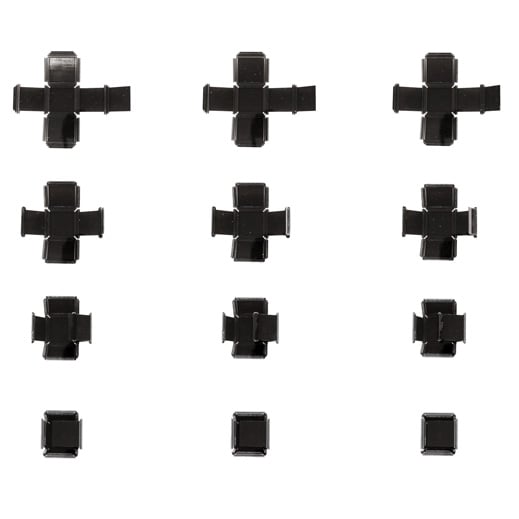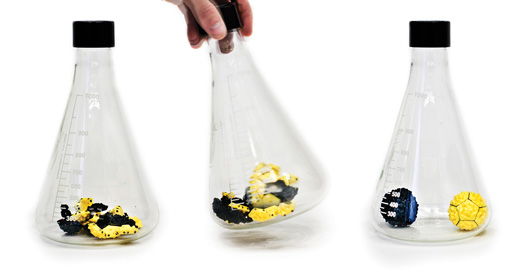Build Thyself
From his office on the fourth floor of Building 5, Skylar Tibbits, SM ’10, has a front-row seat on the construction of the $600 million Novartis research center. It’s the state of the art in building fabrication—and a hive of human activity. After all, even the most precisely engineered steel, concrete, and glass still need to be wrestled into place by hand or with the help of machines.

Computers have changed the way we design buildings. But they haven’t changed much about the way we assemble them. What if materials could be encoded with information and designed to assemble themselves? “We always assume that materials are stupid, they’re cold, they’re dumb,” Tibbits says. “We have to force them into place, and we have to tell them what to do.” Tibbits, a research scientist in MIT’s Department of Architecture, has a different vision: one in which “materials can make decisions, they can have information, they can respond, they can be active.”
The idea, he says, isn’t to put construction workers out of work. It’s just that with smart materials, humans, machines, and materials can each do what they do best: “You can say, what are the humans good at? We’re good at creativity, we’re good at decision-making. What are machines good at? They’re good at repeatability, precision. What are materials good at? Responsiveness, passiveness, transformation.”
Tibbits’s research focuses on what he calls “smart assembly,” which encompasses two closely related concepts: smart materials and self-assembly. Smart materials (sometimes referred to as programmable, reconfigurable, or transformational materials) respond to environmental factors—light, water, even sound—by altering their shape or other physical properties. The instructions that guide this shape-shifting are embedded in the material itself. Self-assembling materials also follow embedded instructions in response to an external stimulus. But they are separate components that must first find each other before they can come together into their preprogrammed form.

Both concepts are familiar at the nanoscale in the realms of materials science, synthetic biology, and biomedicine. Take the speedy self-assembly, replication, and repair capabilities of complex natural systems such as DNA, which can quickly replicate three billion base pairs. If similar principles could be mimicked and harnessed at the scale of the built environment, a large building with a million parts or a vehicle as complicated as the space shuttle, which had 2.5 million parts, could come together in less time than it takes now. “What differentiates us from any other lab that’s working on these topics is scale,” says Tibbits. “We’re talking about the human scale, the industrial scale.”
Tibbits’s public demos over the past few years suggest some tantalizing possibilities. At a 2011 TED conference, for example, he demonstrated “biased chains,” plastic chains made of identical interlinked elements designed to turn either to the right or to the left. He gave one chain a few shakes, and it twisted into a cube; another formed a spiral. In 2012, he and biologist Arthur Olson demonstrated biomolecular self-assembly using small glass beakers containing a handful of magnetized components. When a beaker is shaken, the components find each other and form a unique molecular shape.
Tibbits’s most attention-grabbing work to date has been on 4-D printing, which he developed in 2013 with Stratasys, a manufacturer of 3-D printers, and Autodesk, a maker of 3-D design software. The process builds on multimaterial 3-D printing using a special material that can change its shape over time—the fourth dimension. A demo that he showed off at the EmTech conference in 2013 features a simple strand of black plastic with regular cuts along its length. Dropped into a fish tank of water, the strand folds itself into the letters “M-I-T”; another strand folds into a cube. How? Each strand is made of two materials: a white core that expands when it meets water, and a rigid black coating. Varying the thickness of the two materials as they were printed “programmed” the strands to fold into specific angles when wet. In another demo, a flat sheet dipped in water folds into a cube, and a 50-foot-long strand that’s dunked in the Z Center swimming pool folds 75 times along its length in an hour.

What is the future of Tibbits’s work? “Like 3-D printing, 4-D in the near term is probably of most interest for smaller objects and projects, nothing at a large building scale,” says architect Phil Bernstein, a vice president at Autodesk and a lecturer at Yale. “But over time I suspect these ideas have legs for larger things—like buildings—in creating building elements in circumstances where human or robotic labor isn’t suitable or available.” For instance, a “self-generating” 4-D construction strategy could prove useful in remote spots, under dangerous building conditions (underwater or near utilities or traffic), or in locations where it would be difficult to fit a paintbrush, a hammer, or a person.
The grandson of an architect and trained in architecture himself, Tibbits has enjoyed making things since he was a child playing around with power tools in his dad’s garage. Fittingly, he co-teaches the How to Make (Almost) Anything seminar in MIT’s Media Lab. He’s often asked whether his work could one day lead to such things as buildings that adapt to environmental conditions or consumer electronics that could be assembled with less hand labor. But he prefers to focus on the day-to-day work of making new objects to test his ideas and working with industry partners to develop near-term applications. His lab turns out as many as five to 10 prototypes a day, using a 3-D printer, a computer-controlled cutting machine known as a CNC router, and a laser cutter. “Everyone can come up with good ideas,” Tibbits says. “Unless you physically build it, it doesn’t prove anything.”
Keep Reading
Most Popular
Large language models can do jaw-dropping things. But nobody knows exactly why.
And that's a problem. Figuring it out is one of the biggest scientific puzzles of our time and a crucial step towards controlling more powerful future models.
The problem with plug-in hybrids? Their drivers.
Plug-in hybrids are often sold as a transition to EVs, but new data from Europe shows we’re still underestimating the emissions they produce.
Google DeepMind’s new generative model makes Super Mario–like games from scratch
Genie learns how to control games by watching hours and hours of video. It could help train next-gen robots too.
How scientists traced a mysterious covid case back to six toilets
When wastewater surveillance turns into a hunt for a single infected individual, the ethics get tricky.
Stay connected
Get the latest updates from
MIT Technology Review
Discover special offers, top stories, upcoming events, and more.